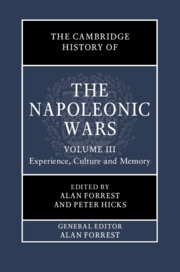Book contents
- The Cambridge History of the Napoleonic Wars
- The Cambridge History of the Napoleonic Wars
- The Cambridge History of the Napoleonic Wars
- Copyright page
- Contents
- Figures
- Maps
- Contributors to Volume III
- Introduction to Volume III
- Part I The Experience of War
- Part II The Experience of Imperial Rule
- 6 Blockade and Economic Warfare
- 7 Crossing Borders: Encounters with the Other
- 8 Popular Resistance: The Case of Napoleonic Italy
- 9 Collaboration: The Case of the Duchy of Warsaw
- 10 Military Resistance: Desertion
- 11 Liberation: Myth and Reality in Germany
- Part III War, Culture and Memory
- Part IV The Aftermath and Legacy of the Wars
- Bibliographic Essays
- Index
11 - Liberation: Myth and Reality in Germany
from Part II - The Experience of Imperial Rule
Published online by Cambridge University Press: 05 August 2022
- The Cambridge History of the Napoleonic Wars
- The Cambridge History of the Napoleonic Wars
- The Cambridge History of the Napoleonic Wars
- Copyright page
- Contents
- Figures
- Maps
- Contributors to Volume III
- Introduction to Volume III
- Part I The Experience of War
- Part II The Experience of Imperial Rule
- 6 Blockade and Economic Warfare
- 7 Crossing Borders: Encounters with the Other
- 8 Popular Resistance: The Case of Napoleonic Italy
- 9 Collaboration: The Case of the Duchy of Warsaw
- 10 Military Resistance: Desertion
- 11 Liberation: Myth and Reality in Germany
- Part III War, Culture and Memory
- Part IV The Aftermath and Legacy of the Wars
- Bibliographic Essays
- Index
Summary
When Johann Gottlieb Fichte delivered his famous ‘address to the German nation’ in the winter months of 1807–8, he could be sure that no seat in the huge hall of the Prussian Academy of Sciences in French-occupied Berlin would be left empty. Students and professors, officers and civil servants, academics and aristocrats, along with other leading figures of society and their wives, poured into the hall to listen to Fichte’s evocation of Germany’s history and glory, his praise of national education and his appeal for a common German identity.1 While French hegemony initially limited the scope of nationalist rhetoric, during the wars against Napoleonic France in 1813–15 sermons, pamphlets, speeches and caricatures were produced at a hitherto unparalleled rate. For this reason, and following the lead given by pro-Prussian writers such as Droysen and Treitschke, historians have often claimed the ‘Wars of Liberation’ as the origins of modern German nationalism. Most prominently, Hans-Ulrich Wehler identified this period as a watershed separating the Early Modern Era from the Age of Nationalism in the nineteenth century.2
- Type
- Chapter
- Information
- The Cambridge History of the Napoleonic Wars , pp. 220 - 238Publisher: Cambridge University PressPrint publication year: 2022

